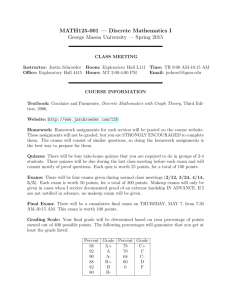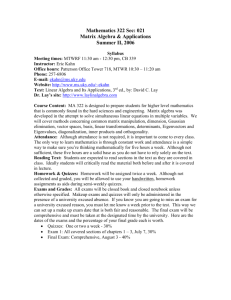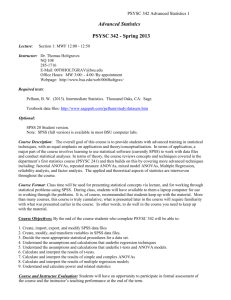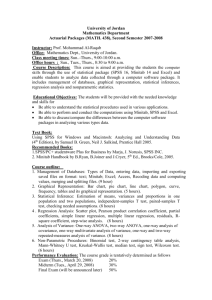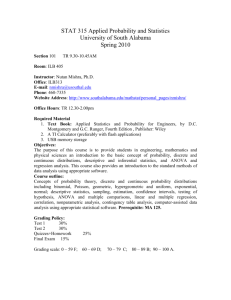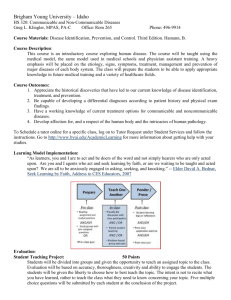Psyc 611 001 Mohr - Courses and Syllabi
advertisement
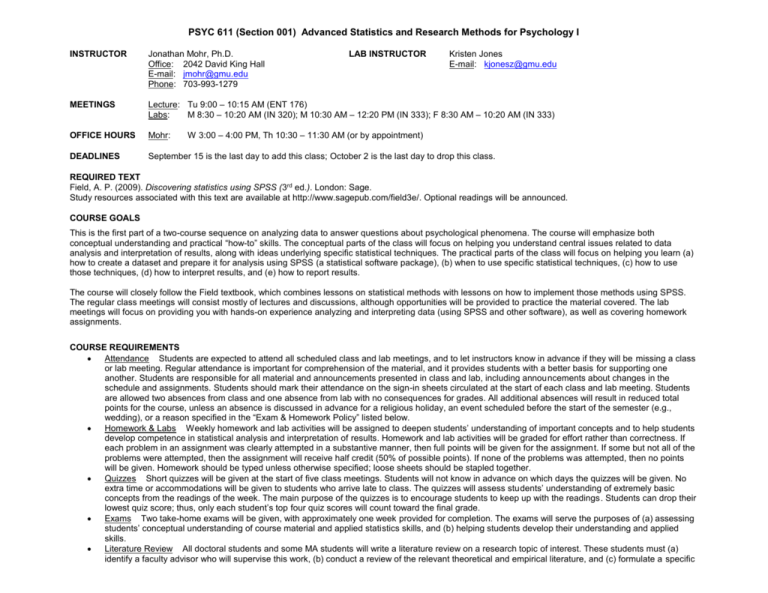
PSYC 611 (Section 001) Advanced Statistics and Research Methods for Psychology I INSTRUCTOR Jonathan Mohr, Ph.D. Office: 2042 David King Hall E-mail: jmohr@gmu.edu Phone: 703-993-1279 LAB INSTRUCTOR Kristen Jones E-mail: kjonesz@gmu.edu MEETINGS Lecture: Tu 9:00 – 10:15 AM (ENT 176) Labs: M 8:30 – 10:20 AM (IN 320); M 10:30 AM – 12:20 PM (IN 333); F 8:30 AM – 10:20 AM (IN 333) OFFICE HOURS Mohr: DEADLINES September 15 is the last day to add this class; October 2 is the last day to drop this class. W 3:00 – 4:00 PM, Th 10:30 – 11:30 AM (or by appointment) REQUIRED TEXT Field, A. P. (2009). Discovering statistics using SPSS (3rd ed.). London: Sage. Study resources associated with this text are available at http://www.sagepub.com/field3e/. Optional readings will be announced. COURSE GOALS This is the first part of a two-course sequence on analyzing data to answer questions about psychological phenomena. The course will emphasize both conceptual understanding and practical “how-to” skills. The conceptual parts of the class will focus on helping you understand central issues related to data analysis and interpretation of results, along with ideas underlying specific statistical techniques. The practical parts of the class will focus on helping you learn (a) how to create a dataset and prepare it for analysis using SPSS (a statistical software package), (b) when to use specific statistical techniques, (c) how to use those techniques, (d) how to interpret results, and (e) how to report results. The course will closely follow the Field textbook, which combines lessons on statistical methods with lessons on how to implement those methods using SPSS. The regular class meetings will consist mostly of lectures and discussions, although opportunities will be provided to practice the material covered. The lab meetings will focus on providing you with hands-on experience analyzing and interpreting data (using SPSS and other software), as well as covering homework assignments. COURSE REQUIREMENTS Attendance Students are expected to attend all scheduled class and lab meetings, and to let instructors know in advance if they will be missing a class or lab meeting. Regular attendance is important for comprehension of the material, and it provides students with a better basis for supporting one another. Students are responsible for all material and announcements presented in class and lab, including announcements about changes in the schedule and assignments. Students should mark their attendance on the sign-in sheets circulated at the start of each class and lab meeting. Students are allowed two absences from class and one absence from lab with no consequences for grades. All additional absences will result in reduced total points for the course, unless an absence is discussed in advance for a religious holiday, an event scheduled before the start of the semester (e.g., wedding), or a reason specified in the “Exam & Homework Policy” listed below. Homework & Labs Weekly homework and lab activities will be assigned to deepen students’ understanding of important concepts and to help students develop competence in statistical analysis and interpretation of results. Homework and lab activities will be graded for effort rather than correctness. If each problem in an assignment was clearly attempted in a substantive manner, then full points will be given for the assignment. If some but not all of the problems were attempted, then the assignment will receive half credit (50% of possible points). If none of the problems was attempted, then no points will be given. Homework should be typed unless otherwise specified; loose sheets should be stapled together. Quizzes Short quizzes will be given at the start of five class meetings. Students will not know in advance on which days the quizzes will be given. No extra time or accommodations will be given to students who arrive late to class. The quizzes will assess students’ understanding of extremely basic concepts from the readings of the week. The main purpose of the quizzes is to encourage students to keep up with the readings. Students can drop their lowest quiz score; thus, only each student’s top four quiz scores will count toward the final grade. Exams Two take-home exams will be given, with approximately one week provided for completion. The exams will serve the purposes of (a) assessing students’ conceptual understanding of course material and applied statistics skills, and (b) helping students develop their understanding and applied skills. Literature Review All doctoral students and some MA students will write a literature review on a research topic of interest. These students must (a) identify a faculty advisor who will supervise this work, (b) conduct a review of the relevant theoretical and empirical literature, and (c) formulate a specific research question to address. Students must ensure that their faculty advisor sends me an email by September 27 stating that s/he is willing to supervise and grade the student’s work on the literature review requirement for this course. Students should make sure their advisor knows that s/he is responsible for supervising work on the literature review and sending me a grade by December 13 at the very latest. The grade should be in the usual percentage format (e.g., 90-100% = A). EXTRA CREDIT All students will have the opportunity to participate in an experiment (or lecture alternative) for extra credit worth 1% of the total course points. The experiment will involve attending two sessions over two weeks in which you will have an opportunity to practice concepts we cover in lecture and lab. The experiment will be run just like a lab session. For information about the experiment or lecture alternative, you may contact the researchers: David M. Cades (dcades@gmu.edu) or Dr. Deborah A. Boehm-Davis (dbdavis@gmu.edu). EVALUATION AND GRADES The total score for the course will have a possible range of 0-100. It will be based on the following weighting of course requirements (see Grade Tracking Form to monitor your progress and see how the total score is calculated): Literature Review No Literature Review Attendance 10% 10% Homework & Labs 30% 40% Exams (2) 40% (20% each) 40% (20% each) Quizzes 10% 10% Literature Review 10% A final grade of B denotes work that meets course objectives and demonstrates the level of comprehension and skill expected of graduate students. Work exceeding this standard receives an A. Note that a grade of C or lower denotes an unsatisfactory level of achievement for a graduate student. It is worth trying to earn a grade higher than a C since the course will have to be retaken otherwise. However, it is not worth worrying about whether one gets an A or a B since this distinction usually has little practical importance in graduate school or one’s professional development. Please contact me if you think your work has been graded improperly. Final grades will be assigned according to the following percentages (rounding decimals up to the next integer): A = 93-100 A- = 90-92 B+ = 87-89 B = 83-86 B- = 80-82 C+ = 77-79 C = 73-76 C- = 70-72 F = below 70 EXAM & HOMEWORK POLICY The following policy refers to all missed or late exams, quizzes, and assignments that you fail to let us know about beforehand. Not included in this policy are arrangements made beforehand with the professor and lab instructor (e.g., missing class for a religious holiday). There will be no extensions or make-ups without penalty except in instances such as the following: hospitalization or illness that has been documented and judged by your instructor as preventing you from (a) preparing adequately for an exam or quiz, (b) attending class, or (c) completing an assignment death or serious illness in your family court appearances Documentation must be provided by health officials (e.g., a physician or member of the student center health staff) in the case of illness; an immediate family member in the case of a death or serious illness in the family; and official paperwork in the case of court dates. Students failing to produce such documentation will be penalized at least one full letter grade. Decisions related to extensions and make-ups will be made on a case-by-case basis. HONOR CODE Students are expected to abide by the GMU Honor Code: “Student members of the George Mason University community pledge not to cheat, plagiarize, steal, or lie in matters related to academic work.” Exams and assignments are expected to be individual efforts unless noted otherwise by the instructor or teaching assistant. Violations of the GMU Honor Code can result in failure of an assignment or exam, depending on the severity of violation. All violations will be reported to the Honor Committee. Please speak with me if you have good reason to believe that a peer has engaged in a violation of the Honor Code. USE OF TECHNOLOGY The lab section for this course will include instruction in statistical analysis using computer software, with a focus on SPSS. All students in the class will also be expected to check their GMU email account on a regular basis, as email will be used to make announcements and distribute some course materials. Blackboard will be used to post grades, as well as materials for both the lecture and lab. ACCOMMODATION OF DISABILITIES If you are a student with a disability and you need academic accommodations, please see me and contact the Disability Resource Center (DRC) at 703-9932474. All academic accommodations must be arranged through that office. Note that this provision includes the range of disabilities , including physical, psychiatric, and learning disabilities. STUDENT SUPPORT SERVICES George Mason offers services to support students’ academic development and emotional development. The Learning Center, locate d in SUB I (room 364, see http://www.gmu.edu/departments/csdc/ls.htm), offers workshops in academic skills and a tutor referral program. The Counseling Center, located in SUB I (room 364, see http://www.gmu.edu/departments/csdc/), offers stress management training, as well as individual and group counseling for students who would like some help with social, emotional, or educational concerns—or who have concerns about their friends. Consider taking advantage of these free resources. ATTITUDE Stats courses can be tough for everyone, even students and instructors who are geekishly attracted to stats. My experience suggests that our semester together will be positive to the degree that we can cultivate certain attitudes: Sense of community We’re in this together. If you see someone struggling with something you understand, offer a hand. Focus on learning Statistics involves skills that every person in this class is capable of learning. Acquiring those skills depends on your willingness to work hard and persist in the face of challenging material rather than whether or not you believe you are a “stats person.” Put your time into learning the material rather than worrying about how good or bad you are at stats. Value of communication It is impossible to address your questions and concerns if you don’t speak up. Please ask questions, ask for help, and let me know if there are aspects of the course that you think could be improved. TENTATIVE SCHEDULE Students are responsible for being aware of any changes in this schedule announced in class or lab. Week Lecture Topic Reading Lab Topic 8/31 Intro to class. Intro to variables (variable types, measuring variables, frequency distributions, scoring). Field “How to Use This Book”; 1; Lab: Field 3 SPSS data management. Introduction to syntax. 9/7 Basic descriptive statistics (central tendency, variability, z scores, areas under the standard normal curve). Exploring and visualizing distributions; exploring assumptions. Field 2.1-2.4, 5.1-5.6 Lab: Field 4.1-4.5, 4.9 Lecture topics. Splitting & sorting files. Tables of descriptive stats. No Monday labs this week. 9/14 Correcting problems in the data. Basic concepts of inferential statistics. Field 2.5-2.6, 5.7 Lecture topics. Graphing means with error bar charts. 9/21 Covariance, correlation; partial and semipartial correlations; comparing correlations. Due this week: Email from advisors about literature review. Field 4.8.1-4.8.4; 6 Lecture topics. Importing data into SPSS. Correlation tables. 9/28 Simple linear regression. Introduction to power analysis. Introduction to multiple regression. Field 7.1-7.5 Lecture topics. Intro to G*POWER. 10/5 Multiple regression (basics, types of regression, assumptions). Field 7.5-7.10 Lecture topics. Regression tables. 10/12 No class Tuesday: Monday classes meet on Tuesday Field 7.11 Lecture topics. 10/19 One and two group t tests: basics, power, graphing means. Midterm exam is distributed on Tuesday. Field 4.8, 9 Lecture topics. Two group tables. 10/26 ANOVA (basics, post hoc tests). Midterm exam is due in class Tuesday at start of class. Field 10 (except 10.2.11, 10.3.1, 10.4.2) Lecture topics. Pot hoc tables. 11/2 ANOVA (planned comparisons, ANOVA as multiple regression). Field 10.2.11, 10.3.1, 10.4.2 Lecture topics. 11/9 ANCOVA. Introduction to factorial ANOVA Field 11 Lecture topics. 11/16 Factorial ANOVA. Interactions between categorical and continuous predictors Field 12 Lecture topics. Graphing interactions. 11/23 Reliability of measurement Field 17.9-17.10 Same as lecture topics. No Friday lab this week. Multiple regression (power; categorical variables). No class: Thanksgiving 11/30 Qualitative analysis. 12/7 Catch up. Pulling it all together. Final exam is distributed on Tuesday. Due this week: Literature review grades from advisors. 12/14 Final exam is due at my office by 5:00pm on 12/15. Creswell et al. (2007) Same as lecture topics. Reliability; Lab “open house.” WEBSITES Here are some stats-related websites that I have found useful in my own work. There are many other good stats websites out there. http://www.ats.ucla.edu/stat/ One of the most useful stats websites in the universe. It includes many tutorials in using stats software for different types of analyses, some of which are videos. It also provides general guidance (e.g., how to decide what statistical test to use). Bookmark this page! http://www.spsstools.net/ Need some SPSS syntax or script to make your life easier? You may well find it here, at Raynald’s SPSS Tools website. http://www.people.ku.edu/~preacher/ Kristopher Preacher’s website, which includes excellent material on mediation and moderation, including lots of SPSS syntax. http://flash.lakeheadu.ca/~boconno2/boconnor.html Brian O’Connor’s website, which includes SPSS syntax that can be very handy (e.g., parallel analysis, analysis of dyadic data). http://www.comm.ohio-state.edu/ahayes/ Andrew Hayes’s website, which also includes some handy SPSS syntax (can you say “Krippendorff”?). http://www.jeremydawson.co.uk/slopes.htm Some useful Excel programs to probe 2-way and 3-way interactions in multiple regression. http://statpages.org/javasta2.html This page lists links to FREE statistical software. You will be surprised at how much is out there at no cost. http://www.psych.umn.edu/faculty/waller/ Niels Waller’s website, which includes great stats reading lists and links to useful stats and computer-related resources. http://biostat.mc.vanderbilt.edu/twiki/bin/view/Main/PowerSampleSize This is the website for PS, another free power analysis software program. http://www.psycho.uni-duesseldorf.de/abteilungen/aap/gpower3/ This is the website for G*Power 3, which is a free power analysis software program. Very useful for when your thesis committee asks you to justify whether your proposed sample size of two million PSYC 100 students or rats is sufficiently large. CLASSROOM CONTACTS Please write down the names and contact info of two classmates, in case you miss class and need notes or other forms of assistance. Name: ________________________________________ Contact Info: ________________________________ Name: ________________________________________ Contact Info: _______________________________ Grade Tracking Form Instructions: Track your scores for each of the five course requirements using the five tables below. To calculate your total score for the course, complete the Total Score Calculation Table at the very bottom of this sheet. To use that table, simply (1) plug in the “actual” points divided by the “possible” points for each of the five course requirements, (2) multiply this fraction by the corresponding weight to get the “weighted score,” and (3) add the weighted scores to get the total score for the course. ATTENDANCE # classes (up to 26) Actual Possible HOMEWORK & LABS # labs (up to 13) + + 26 Homework points QUIZZES LITERATURE REVIEW 100 Q1 Actual Possible 5 = = Final + + Q2 5 Q3 5 Q4 5 Sum = = 100 Q5 5 Sum (top 4) = = 20 Points Actual Possible 100 TOTAL SCORE CALCULATION TABLE Attendance Homework & Labs Exams (2) Quizzes Literature Review Total Score A = 93-100 B+ = 87-89 C+ = 77-79 Literature Review Actual/Possible Weigh Weighted t Score * 10 * 30 * 40 * 10 * 10 = A- = 90-92 B = 83-86 C = 73-76 B- = 80-82 C- = 70-72 39 Sum + + Midterm Actual Possible 13 Lab points Actual Possible EXAMS Sum = = No Literature Review Actual/Possible Weigh Weighted t Score * 10 * 40 * 40 * 10 = F = below 70 200
